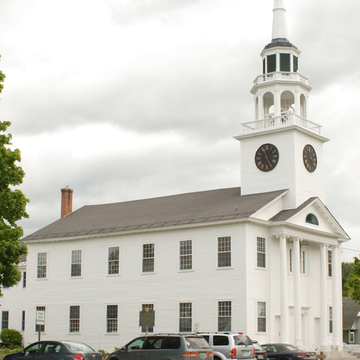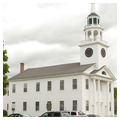The construction of this fine Federal church marked a shift in community focus from the original, elevated Norwich town center, a mile to the north, to Burton's Plain, nearer to the river and along the Chelsea Turnpike. Local tradition attributes the building to Ammi B. Young, though he would have been only nineteen years old, and he was twenty-seven when he received his first documented commission. A more likely designer is local builder Thomas Emerson, who was a founder of the church and participated in raising its frame; he was also one of the four Emerson brothers who worked as carpenters in the Norwich area. The general composition of the church is derived from plate 33 of Asher Benjamin's The Country Builder's Assistant (1797), but with significant adjustments. In place of the pavilion there is an open portico carried on tall Ionic columns spaced with reference to the doors and Palladian window of the wall behind. This and the multistage tower with spire suggest a fusion of the Benjamin tradition with that of so-called Templeton Run, a series of contemporary meetinghouses in northern Massachusetts and southwestern New Hampshire inspired by Elias Carter's Federated Church (1811) in Templeton, Massachusetts. The detailing of the Norwich church is particularly fine, including the sophisticated use of flush boards for the porch and pediments, the paired paneled pilasters of the main door, and the semielliptical recess and petal-shaped muntin work of the Palladian window. Also notable are the drilled mutules of the cornice and the pilasters and full entablature of the arcaded octagonal belfry. The building was originally set on the Norwich green on the east side of Main Street and as a visual terminus to Elm Street. In 1853 it was moved to its present location overlooking the green. At that time, it was lengthened by one bay. The interior was significantly remodeled in 1908.
You are here
Norwich Congregational Church
If SAH Archipedia has been useful to you, please consider supporting it.
SAH Archipedia tells the story of the United States through its buildings, landscapes, and cities. This freely available resource empowers the public with authoritative knowledge that deepens their understanding and appreciation of the built environment. But the Society of Architectural Historians, which created SAH Archipedia with University of Virginia Press, needs your support to maintain the high-caliber research, writing, photography, cartography, editing, design, and programming that make SAH Archipedia a trusted online resource available to all who value the history of place, heritage tourism, and learning.












